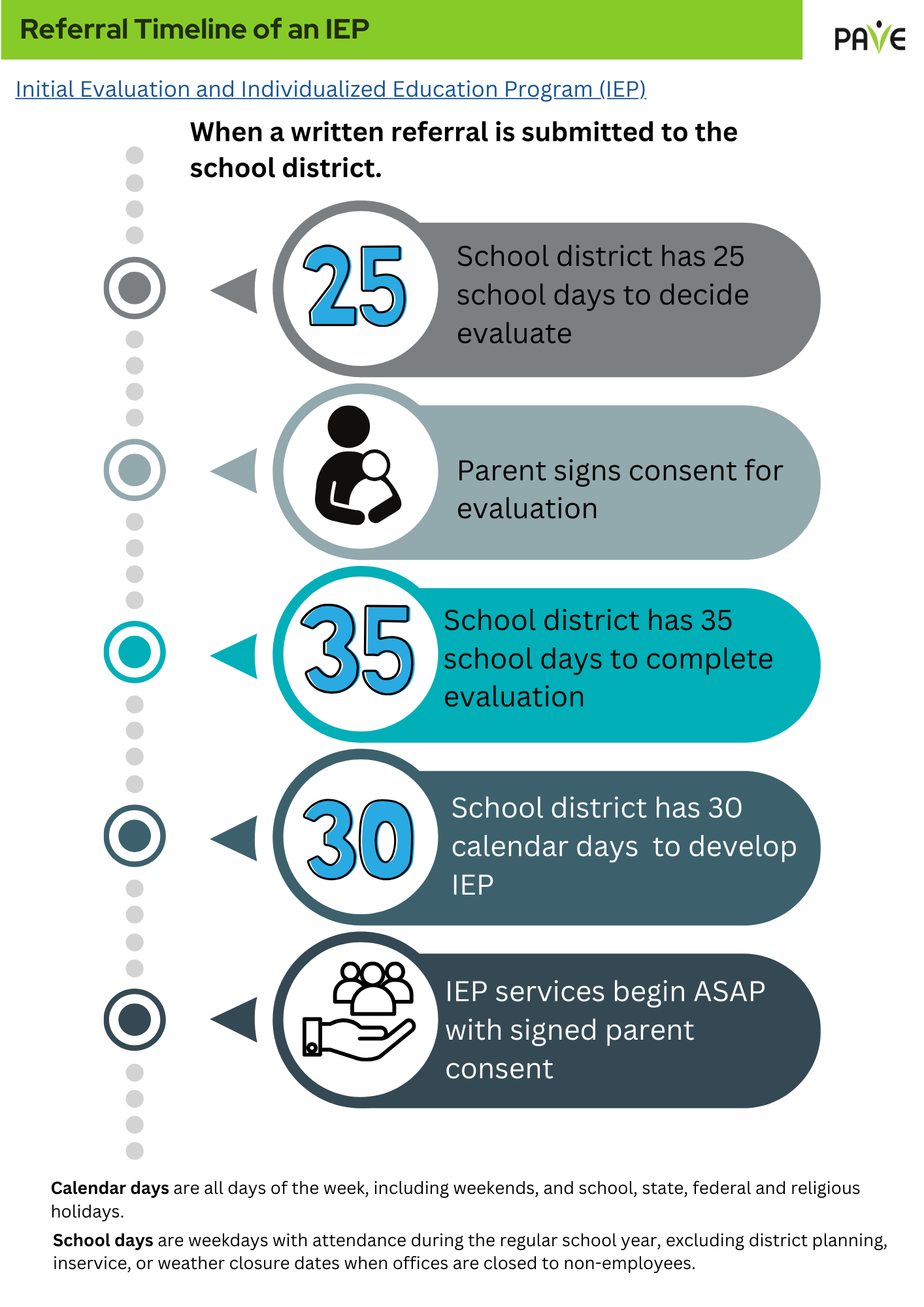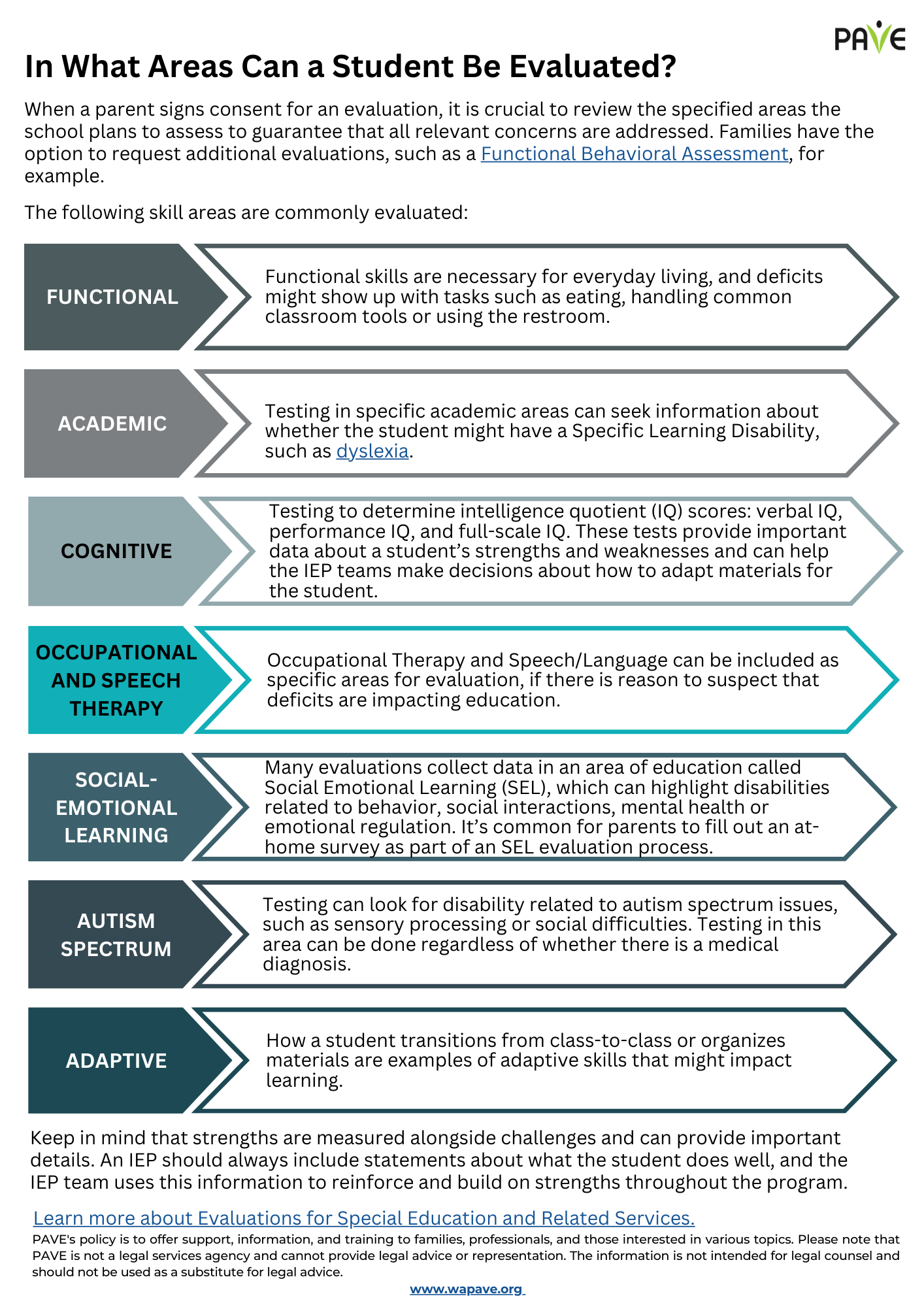A Brief Overview
- Washington State requires special education referrals to be in writing (WAC 392-172A-03005). Anyone with knowledge of a student can write a referral.
- The state provides a form for making a special education referral, downloadable from a website page titled, Making a Referral for Special Education. The form is not required—any written request is valid.
- Schools are responsible to provide families with a referral form in their native language and to provide qualified interpreters so families can participate in all meetings to discuss their student’s special education eligibility and services.
- Another option is to write a referral using the sample letter at the end of this article.
- Evaluation process and family/student rights are described in the special education Procedural Safeguards, updated in 2022.
Full Article
When a student is struggling in school and there is reason to suspect the challenges are disability related, anyone can refer the student for an educational evaluation. If the evaluation shows that the student is eligible, services are provided through an Individualized Education Program (IEP). Washington State requires special education referrals to be in writing (WAC 392-172A-03005).
If someone who knows the student asks for an evaluation, the school is responsible to:
- Document the request
- Record the date the referral was made
- Provide a referral form in the person’s native language
- Respond to the request within 25 school days
If the person asking for the evaluation cannot write, the school is responsible to support them to complete the referral.
The school must provide a referral form in the native language of the person making the request. Schools are required to provide qualified interpreters to support parent participation in the referral process and for all meetings where a student’s eligibility and/or educational services are discussed. See Parent Rights Information Sheets, downloadable in many languages.
Here’s a summary of evaluation timelines:
- The school has 25 school days to respond to a referral.
- After a parent/caregiver signs consent, the school has 35 school days to evaluate the student.
- If eligibility is found, the school has 30 calendar days to write an IEP and seek parent/caregiver consent for services to begin.
The Office of Superintendent of Public Instruction (OSPI) is the guidance agency for Washington State. OSPI provides a form for making a special education referral, downloadable from a website page titled, Making a Referral for Special Education. Families may use OSPI’s form, a form provided by their school, or their own choice of format to write their request for a student to be evaluated. PAVE’s sample letter at the end of this article is an option.
A non-discriminatory evaluation is part of the protections for a student with a known or suspected disability that may significantly impact their access to education (Child Find Mandate). Child Find protections are part of the federal Individuals with Disabilities Education Act (IDEA). Child Find applies whether there are academic and/or non-academic school impacts.
PAVE provides more detail about IEP eligibility and evaluation process: Evaluations Part 1: Where to Start When a Student Needs Special Help at School.
The clock starts ticking when a request is made
The school has 25 school days after the initial request date to decide whether to evaluate the student who was referred. School days are days when students attend school. The school district lets the family know their decision through a formal letter called Prior Written Notice (PWN), which is described in the Washington Administrative Codes (WAC 392-172A-05010).
Often the school and family meet to discuss the referral and how the student is doing. If all agree to proceed with an evaluation, parents sign consent for the testing to begin. The family can ask questions about what the evaluation will include. Evaluating all areas of suspected disability and educational impact is important to learn as much as possible about the student’s strengths and needs. Information from the evaluation is used to build the services program if the student is found eligible for an IEP.
If the school says no to the evaluation and the family disagrees, they have dispute resolution options that are described in special education Procedural Safeguards, updated in 2022.
Parent consent is required
When the school agrees to evaluate the student, staff must promptly seek parent consent to begin the evaluation process (WAC 392-172A-03005).
Generally, parents sign a form that lists what the school will include in its evaluation. Parents can ask for additional areas to be evaluated to make sure the school gets data for all areas of concern. Families can ask for more information about what the evaluation will look like, where it will take place, how long it will take, and who will participate. The school and family can creatively plan the evaluation process if accommodations are needed. For example, if a student isn’t able to attend in-person school, the evaluation can be done in alternative locations.
After a parent signs consent, the school has 35 school days to finish the evaluation and meet with the family to talk about the results. The deadline may be extended if the family agrees, particularly to accommodate needs of the family or student.
The 35-day deadline does not apply if the student is unavailable for the evaluation or enrolls in another school district before the evaluation is finished (WAC 392-172A-03005).
For students found eligible for services, the school develops an IEP within 30 calendar days and requests parent consent for services to begin. The school and family meet to review a DRAFT version of the IEP and write a final version together before consent is signed. School staff provide a Prior Written Notice (PWN) with a summary of the meeting, agreements, and timelines before services start. PWN requirements are described in WAC 392-172A-05010.
Special Education is a service, not a location within the school
A request for a special education evaluation is NOT a recommendation to remove a student from the regular classroom and move them into an exclusive learning environment. Federal and state laws require that students receive education and services in the Least Restrictive Environment (LRE) to the maximum extent possible to meet their needs.
Decisions about placement are made by the IEP team, which includes the family. The IEP team is responsible to consider the child’s circumstances and capacities as its top priority—not pre-built programs or district resources.
Special Education is a service, while LRE refers to placement. PAVE’s article provides further information: Special Education is a Service, Not a Place. Another article provides detail about parent participation in special education process: Parent Participation in Special Education Process is a Priority Under Federal Law.
Parents can appeal decisions and/or seek a 504 plan
If a student is evaluated and found not eligible for an IEP (or if the school refuses to do an evaluation), the family has the right to dispute the decision using Procedural Safeguards.
If they disagree with the district’s evaluation or its findings, the family may seek an Independent Educational Evaluation (IEE), which is done by an agency outside of the school district. The district must pay for an IEE or deny the request using Due Process. See PAVE’s article: Evaluations Part 2: Next Steps if the School Says ‘No’ to Your Request. The article includes a sample letter to request an IEE.
Another option if a student doesn’t get an IEP is to develop a Section 504 Plan, which accommodates a person with a disability that impacts a major life activity (learning, walking, speaking, writing, socializing…). Section 504 is part of the Rehabilitation Act of 1973, which protects the civil rights of individuals with disabilities against discrimination throughout their lives. See PAVE’s article about Section 504 rights, which also protect students who qualify for an IEP: Section 504: A Plan for Equity, Access and Accommodations.
Sample letter for a special education referral
Below is a sample letter to write a request for a special education evaluation. You can copy and paste the text of this sample letter into your word processor to build your own letter.
The state provides an alternative form, downloadable from OSPI’s website page titled, Making a Referral for Special Education. Your school district is responsible to provide a form, in your language, for you to submit your written request. These formats are your choice—any written request is valid. If you cannot write, you can ask for an evaluation by telling the school and they can write the request with you.
Submit your written request through email, by mail, or by hand delivery, to the special education/special services manager at your school’s district office. You may submit additional copies to school administrators and/or a school psychologist—the person who manages evaluations for your school. Be sure to keep copies of all of your communications with the school in an organized, safe place.
Your Name
Your relationship to the student
Your phone number
Your email address
The date you submit the request
To: [name of person and/or district],
I am requesting a full and individual evaluation for NAME, (birth date: 00-00-0000), for assessment as a special education student as stipulated in the Individuals with Disabilities Education Act, (IDEA, Public Law 108-446), and in the Washington Administrative Code (WAC 392-172A). My child is being evaluated for the first time [or include information if student was previously evaluated or received IEP or Section 504 services].
My student attends [name of school] and is currently in [grade level]. We speak [language] in our home, and we need a qualified interpreter for all meetings where our child’s eligibility and services are discussed.
I have concerns that (NAME) is not receiving full educational benefit from school because of their struggles with [brief summary of biggest disability-related concern].
I understand that the evaluation is to be in all areas of suspected disability, and that the school district is to provide this evaluation at no charge to me. My reasons for requesting this evaluation are: [be as specific as you can/note that OSPI’s form suggests possible academic and physical/behavioral concerns]
- Use bullet points.
- Use bullet points.
- Use bullet points.
Here are some areas where [name] is struggling:
- Use bullet points.
- Use bullet points.
- Use bullet points.
Based on what I know about my student, here are some supports that I think are needed:
- Use bullet points.
- Use bullet points.
- Use bullet points.
[Name] has been medically diagnosed with [Diagnoses, if available… Or you might write: Name is awaiting a medical evaluation for … Note that a medical diagnosis is not required for schools to conduct an educational evaluation and to find a student eligible for services].
I have attached documentation from [list any outside providers who provided letters or reports]. Please take note that [Dr. NAME] recommends [highlight any specific recommendations from those attached documents] because [reason].
I understand that I am an equal member of the team for development of an Individualized Education Program (IEP) and that I will be involved in any meetings related to evaluation, identification of disability, provision of services, placement, or other decisions regarding my child’s access to a Free Appropriate Public Education (FAPE). I would appreciate meeting with each person who will be doing an evaluation before [NAME] is tested so that I might share information and history. I will expect a copy of the written report generated by each evaluator so that I might review it before the team meeting.
I understand you must have my written permission for these tests to be administered, and I will be happy to provide that upon receipt of the proper forms.
I appreciate your help in behalf of [NAME].
Sincerely,
Your Name
CC: (Names and titles of other people you give copies to)
Please Note: PAVE is a nonprofit organization that provides information, training, individual assistance, and resources. PAVE is not a legal firm or legal service agency, and the information contained in this handout is provided for informing the reviewer and should not be considered as a means of taking the place of legal advice that must be obtained through an attorney. PAVE may be able to assist you in identifying an attorney in your area but cannot provide direct referrals. The contents of this handout were developed under a grant from the US Department of Education. The contents do not represent the policy of the US Department of Education and you should not assume endorsement by the Government.



